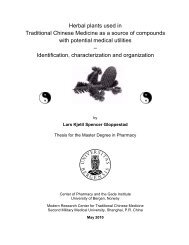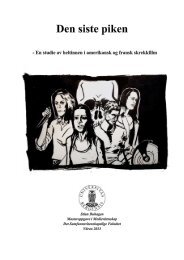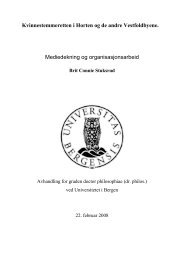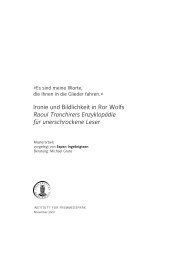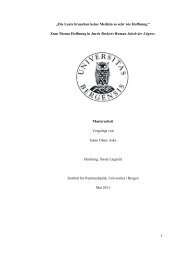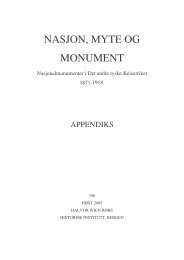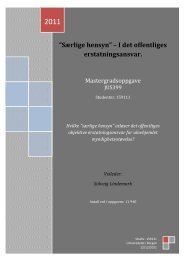View/Open - Bora - Universitetet i Bergen
View/Open - Bora - Universitetet i Bergen
View/Open - Bora - Universitetet i Bergen
Create successful ePaper yourself
Turn your PDF publications into a flip-book with our unique Google optimized e-Paper software.
8. Abstract/sammendrag<br />
With a detailed introduction to Nordahl Grieg‟s novel, aesthetic viewpoints and political<br />
views, his satirical and political novel, Ung må verden ennu være [The World Must Still Be<br />
Young] (1938), is explored. Using Mikhail Bakhtin‟s chronotope theory, the thesis provides a<br />
generic chronotopical analysis of Ung må verden ennu være as a whole. However, of all the<br />
chronotopes mentioned by Bakhtin in his essay, Forms of Time and of the Chronotope in the<br />
Novel : Notes toward a Historical Poetics (1981), the main focus of the thesis is how the<br />
chronotope of the rogue, the clown and the fool is used as a satirical tool by Grieg. Through<br />
this chronotope, the author utilises the characters as extensions and facilitators of his satirical<br />
message. Given how the chronotope of the rogue, the clown and the fool transcends the<br />
boundaries of the text itself and includes the author, the historical and political context<br />
surrounding Grieg‟s novel is taken into account as well.<br />
Methods include identifying characters in Ung må verden ennu være which<br />
correspond with the hallmarks of the characters in Bakhtin‟s chronotope, and, once identified,<br />
exploring how the particular characters function in relation to Nordahl Grieg‟s satire and<br />
political message. The main findings, with respects to Ung må verden ennu være, are how the<br />
characters Hugh Redfern, Ivan Borisovitsj Lebedeff, Rudolf Lagerhielm, Arild Andersen and<br />
Aksel Fauske correspond to Bakhtin‟s rogue, clown and fool. Although they are relatively<br />
insignificant characters in the plot itself; Redfern, Lebedeff, Lagerhielm, Andersen and<br />
Fauske show themselves to be essential to the novel‟s satirical function. It is the use of these<br />
archetypal characters – the rogue, the clown and the fool – that elevates Grieg‟s novel from<br />
being a mere historical piece, to being a novel steeped in satire. As a consequence of these<br />
findings, it becomes apparent that the utilisation of Bakhtin‟s satirical concepts, among<br />
others: «Rabelaisian laughter» and ridicule, does not limit itself to the satirical authors of<br />
antiquity, the Renaissance or the Enlightenment. Although Bakhtin limits his discussion of<br />
satire to older forms of literary genres, his concepts seem to be fully applicable to modern<br />
novels as well. This connection shows that the old folkloric characters of the rogue, the clown<br />
and the fool, have become ingrained devices in narratology, and is still being used today. The<br />
results of the analysis therefore yield a narratological meta-perspective and insight into how<br />
an author might utilise chronotopes when constructing satirical novels. Links between modern<br />
satirical works and the chronotope of the rogue, the clown, and the fool, are fairly unexplored<br />
in Bakhtinian research. As far as Ung må verden ennu være goes, this connection has never<br />
been investigated to a significant extent in previous research.<br />
108




